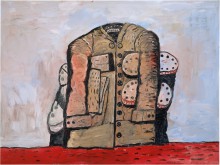Opening in September 2014, the Anderson Collection joins the Cantor Arts Center as Stanford’s second fine arts museum. While the Cantor is a more conventional university museum, the Anderson Collection focuses exclusively on modern and contemporary American art, organized by theme and movement. While works by popular New York School Abstract Expressionists might be top draws, the Anderson’s thoughtful galleries on less well-known California movements—Bay Area Figurative art, California Funk, Light and Space—are the real stars of the show. Taken as a whole, the collection suggests a new narrative for American contemporary art—one in which California artists and institutions surpassed their New York–based counterparts to assume the mantle of the American avant-garde.
This narrative is initially taken up in two small galleries just behind Still’s painting. On the museum’s outer perimeter is a pair of rooms featuring minimalist paintings by Robert Motherwell, Mark Tobey, Ellsworth Kelly, Ad Reinhardt, and Josef Albers. These open up to an expansive hall housing a wealth of New York School Abstract Expressionists. While one wonders why significant works by a subset of New York painters are sequestered to the side, the significance of the larger hall is clear. Anchored at the center by two immediately recognizable paintings—Jackson Pollock’s Lucifer (1947) and Mark Rothko’s Pink and White over Red (1957)—this hall establishes the Anderson Collection as a heavy hitter in the world of postwar American art.
Just past the Abstract Expressionists is another large hall dedicated to Bay Area Figurative artists. David Park’s Four Women (1959) applies the dynamic, aggressive brushwork and imposing scale of Abstract Expressionism to a composition of four posing nudes. Richard Diebenkorn’s Girl on the Beach (1957) uses a palette of ochre and blue to depict a woman reclining against a chair with a book in her lap. The depth and shadows that give the figure weight and dimension contrast the abstracted background of sand, ocean, and sea. Christopher Brown’s 1946 (1992), the Anderson’s newest work of Bay Area Figurative art, depicts a crowd of figures rushing away from the viewer, with an American flag waving in the upper red corner, in foreboding shades of red, white, and black.
The Anderson Collection also emphasizes Stanford’s role in the Bay Area artistic community, dedicating significant space and attention to the work of the former Stanford professor Nathan Oliveira. A second generation Bay Area Figurative painter and a personal friend of the Andersons, Oliveira is the only solo artist in the museum given a dedicated placard describing his work and significance. Two of his paintings, Reclining Nude (1958) and Stage #2 with Bed (1967) convey Oliveira’s initial embrace and later rejection of the stylistic tenets of the movement. Reclining Nude is a luminescent, thickly layered textural work, abstracted to the point of obscuring the figure, which appears as a gash rupturing the gray background. Stage #2 with Bed has a slick, flat, almost photographic surface. In dark colors it depicts a stark empty room with a simple bed, barely illuminated by a dim lamp and a light coming in from the hallway; a figure is notably absent.
The pieces representing California Funk, just past Bay Area Figuration, have a more lighthearted, playful spirit. William Allan’s Half a Dam (1971), a painting of water rushing past a half-broken dam, uses a visual and linguistic pun to convey Allan’s indifference to the art establishment. David Gilhooly’s Hoarding My Frog Food (1982), a ceramic sculpture of a man nearly toppled by a mountain of hamburgers containing frogs between the buns, offers a humorous critique of consumer culture. Tom Holland’s Votto (1979), a vibrant, sculptural “free-standing painting” of candy-colored epoxy paint splattered over molded sheets of aluminum, is at once playful and industrial.
The California Light and Space exhibit occupies several halls across the atrium from Bay Area Figuration and California Funk, ultimately joining back up with the New York minimalist galleries. Larry Bell’s Glass Cube (1984) evokes a cool, cerebral geometric minimalism. Robert Irwin’s Untitled (1969) is a softly glowing white orb with a silver band across the diameter, suspended over a white acrylic background. With its rounded edges, gentle shading, and clean finish, it suggests a possible antecedent to Silicon Valley’s ubiquitous tech aesthetic.
What influence the Anderson Collection will have on Silicon Valley’s artistic community remains to be seen. Its emphasis on California and Bay Area artists as the vanguard of postwar artistic innovation could fuel the solipsistic narrative of progress that Silicon Valley’s tech industry likes to tell about itself: that it creates the future while the rest of the world watches.2 Yet the Anderson Collection invites reflection on the role that Stanford University once played in supporting a vital creative landscape in the Bay Area. Throughout the museum, exhibition placards highlight the role of Bay Area schools and museums in fostering creative risk taking. Nestled among Palo Alto’s venture capital firms and start-up incubators, the Anderson Collection is a reminder that Bay Area artists also need angel investors and institutional support.
The Anderson Collection is open to the public weekly; admission is free.
Notes
- Williams, Thomas. The Bay Area School: California Artists from the 1940s, 1950s, and 1960s. (London: Lund Humphries, 2013).
- Wessel, Maxwell. “Don’t Build Your Startup Outside of Silicon Valley.” Harvard Business Review. 23 Oct 2013. <https://hbr.org/2013/10/dont-build-your-startup-outside-of-silicon-valley>.





